Eyewitness Account
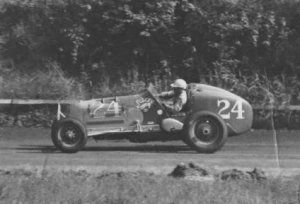
Ted Horn dominated the Labor Day, 1946 race at Lakewood Speedway. He was the dominate force in dirt track racing after World War II. He was also the driving hero of T.C. Chambers of Atlanta. Photo courtesy GARHOFA
T.C. Chambers, of Atlanta Georgia, is a former marine who has long had a love for racing. He had two heroes in life, Ted Horn and Atlanta motorcycle racer Ted Edwards. Chambers would follow Edwards into motorcycle racing, becoming an AMA Pro Dirt Tracker in the 60s. He’s also served in various race official capacities over the years.
Chambers was nine years old on Labor Day of 1946. His father, Ralph, took him out to Lakewood Speedway to see his first race on that day.
“We were part of the non-paying crowd that sat over there on the bank,” Chambers said. “We were on the bank near the third turn where this accident happened.”
They hadn’t started out on that lower bank. They had originally been up on the larger bank just off of the second turn. But Chambers’ father wanted to get closer to the action, so around the halfway point of the 100-lap event, they made their way down to the lower bank located nearer the third turn.
And did they ever get closer to the action.
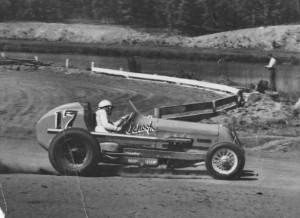
Billy DeVore works his car into turn one at Lakewood. His William Schoof owned Offenhauser was painted orange, which may have made it hard to spot on the very dusty track. Photo courtesy GARHOFA
As nine-year-old T.C. watched, Ted Horn held a commanding lead. Billy DeVore was giving chase.
“What I remember is that the dust was unbelievable,” Chambers said. “With it being 100 laps, they did not stop and water the track. And after 98 laps, you couldn’t’ see.”
With about 15 laps remaining, DeVore suffered some sort of problem. Some reports said his engine went sour, while others said he had a drive shaft problem.
Regardless, DeVore’s car slowed greatly. He moved down to the inside and continued to make laps. At that point in the race, there were only nine of the 11 starters still on the track, and only a couple of those were on the lead lap. By staying out for the remaining few laps, DeVore still stood to pick up a top four or five finish, and a good chunk of the $11,400 purse.
DeVore’s slow moving car did not go unnoticed. Several people on the hill near Chambers pointed him out. In fact, Chambers remembers his father several times pointing out DeVore as he slowly came by through dust, saying, “Here comes old number 17 again, just puttin’ around out there.”
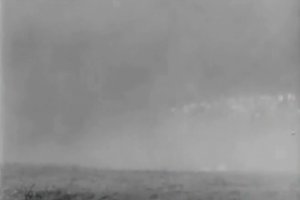
A look at the dusty conditions at Lakewood on Sept. 2, 1946. You can just make out one of the two hills along the backstretch through the clouds in this screen shot from the newsreel of the event.
“DeVore’s car was painted Halloween orange, and it just blended into the dust,” Chambers remembered. “They all knew he was there.”
The color of DeVore’s car may have come into play as the cars came around on the 97th lap of the event. That’s when disaster occurred, and Chambers and his father had a front row seat to history.
–
As DeVore moved down on the inside lane, his orange car moving through the orange dust kicked up from the red Georgia clay, somewhere behind him on the 97th lap came George Robson.
Robson was racing several laps down in the Noc-Out Hose Clamps Special. For whatever reason on that lap, as he came off the second turn, he took a lower line on the straightaway. A little farther back was Texas racer George Barringer piloting the Ervin Wolfe Special. Barringer apparently took his normal line, which brought him to the middle of the track or the lower part of the upper groove on the straight.
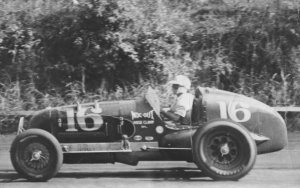
George Robson at speed in the Noc-Out Hose Clams Special at Lakewood, Sept. 2, 1946. Photo courtesy GARHOFA
We’ll never know why Robson picked his particular line. Was the Noc-Out car having issues? Or was he trying to get out of the dust? Regardless, be it due to the color of the car ahead or some other reason, Robson didn’t see DeVore’s stricken car until the last second.
“He may have not been looking for DeVore where he was,” Chambers said. “He might have thought he was somewhere else on the track other than there on the straightaway. So when he ran up on him, he only had a split second.”
Robson moved his car to the right in an attempt to clear the slower moving car of DeVore. But he didn’t realize Barringer was on his outside.
“These cars don’t have rear-view mirrors, and with all the racket from the exhaust on the right, he had to take a chance that nobody would be there,” Chambers said.
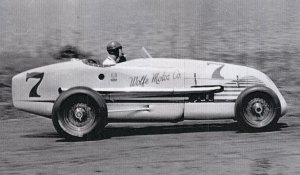
George Barringer piloting the Ervin Wolfe Special at Lakewood, Sept. of 1946. This is the last known photo of Barringer, probably taken during time trials. Note Barringer taking a drag off a cigarette as he rounds turn four. Photo courtesy Bill Barringer
But somebody was there. Barringer was on his outside, and when Robson moved up, it appears that his right rear tire made contact with Barringer’s left front.
In photos of the crash scene, the right rear tire on Robson’s car appears to have been nearly wrenched from the rim, supporting the idea of the contact.
The contact sent Robson out of control, and back down into the slow moving DeVore.
Again looking at Robson’s car at the crash scene, there appears to be significant wear to the left front tire, possibly from contact to DeVore’s car between the right-rear tire and the exhaust.
Regardless, the impact between DeVore’s car, moving 40 miles an hour, and Robson’s now out of control car, moving in excess of 100 miles an hour, was great.
“It made a big ‘whomp’ sound.” Chambers said. “I can still hear that ‘whomp’ today.”

DeVore's car came to rest in the ditch after contact with Robson sent him out of control. This screenshot came from the newsreel of the event, and came after fans helped DeVore from his car.
The impact sent DeVore’s car over the berm on the inside of the track. As his car went up at an angle, it began to overturn, coming to rest upside down in the ditch that ran alongside the backstretch.
Robson’s car became airborne, flipping end over end.
“When the car got upside down, it spit Robson out on the track,” Chambers remembered. “The minute he hit the track, instantly, two cars run over him. I can see it now. He was just flopping and flipping like a rag doll every time one hit him.”
The impact of the hits would send Robson’s body down the track. He came to rest near the cockpit of his upside down racer.
Barringer, meanwhile, had been sent into a spin by his initial contact with Robson. His car came to rest facing into traffic at an angle.
Into this scene came Indiana’s Bud Bardowski. With the accident obscured by the same dust as the rest of the race, Bardowski had no idea of the carnage that lay ahead. He had taken the same line as Barringer off the corner.
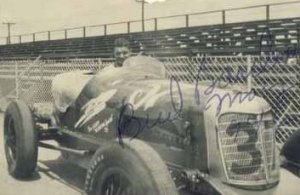
A rare photo of Bud Bardowski. While the number matches, it's unclear if this was the car Bardowski was piloting during the Labor Day race in 1946 at Lakewood.
He roared into the scene at speed, and made hard contact with the stationary car of Barringer, probably around the right front tire and exhaust manifold of the Wolfe Special. Bardowski’s speed would push him past Barringer, shoving Barringer’s car up the track. It would come to rest just ahead of the overturned Noc Out Special.
Judging from the film of the scene, it appears that the steering wheel was shoved back onto Barringer in the impact, causing severe internal injuries.
The newsreel shows officials lifting Barringer from the wreckage. He is limp, but appears to be clinging to consciousness. He would die shortly thereafter at Grady Hospital.
Bardowski received only minor cuts and bruises from the accident.
Chambers remembers that, just as the cars came to rest, a group of fans jumped down onto the track and across to DeVore’s stricken racer. The Kansas driver’s car had come to rest upside down in about four feet of water. The fans turned the car over, freeing DeVore.
“If these guys hadn’t run down the bank and turned his car over, he would have drowned,” Chambers said. “There was four or five feet of water in that ditch.”
DeVore suffered a broken collarbone in the crash.
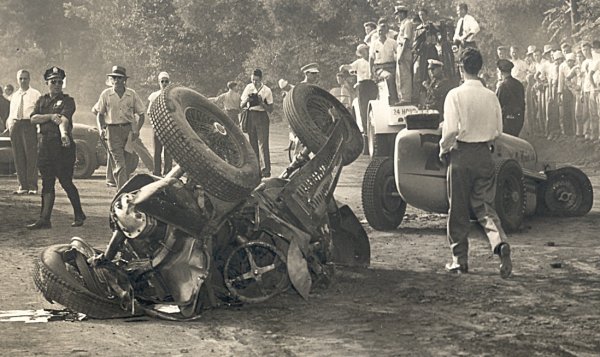
Both Robson's car (pictured left) and Barringer's (pictured right) came to rest just before the culvert on the backstretch. Note the condition of the right-rear tire on Robson's overturned car, suggesting wheel-to-wheel contact. Also note the car located in the left hand background, possibly that of Bud Bardowski. Photo courtesy Eddie Samples
Ted Horn had been leading, and made his way back around to the crash scene. As he came past, he struck a piece of wreckage, possibly the hood from Barringer’s car, which appears in several photos from the scene. Just past the site, Horn stopped and got out, trying to wave down the remaining cars on the track.
Chambers remembers Horn then moving over to check on DeVore before climbing back into his car and driving back around to the pits. He would return to the accident scene later, cleaned up and dressed impeccably (as one would expect of Ted Horn). He can be seen standing behind Robson’s righted car, along with a AAA official in one photo.
After the race had been halted, Chambers and his father moved down off the hill to have a first hand look at the scene.

A stunned Billy DeVore is led from his wrecked racer by two Atlanta police officers. Just over DeVore's left shoulder, and inset in the photo, is nine-year-old T.C. Chambers. Chambers himself did not know of his presence in the photo until he spotted himself during the interview process for this story. Photo courtesy Eddie Samples
“When we got down there, George Robson was lying beside his car,” Chambers remembered. “His head was more or less lying beside him. There was a big pool of blood by him. One of the wrecker drivers, Willie Trout, who I knew, owned a garage nearby. He took the windscreen of Robson’s car, and shuffled up a bunch of dirt and covered that blood with it.”
You can imagine the images left in a nine year old’s mind from that scene. 63 years later, Chambers can recall what Robson was wearing that day.
“I remember he had on wing-tip shoes and no socks, white trousers and a white dress shirt with the sleeves rolled up.”
Chambers remembers turning and seeing Billy DeVore, being led by two Atlanta police officers to a waiting car to take him to the hospital. In photos of that scene, DeVore appears to be in shock. Chambers said DeVore had just passed the same scene of Robson that he had seen.
That’s where the story comes full circle. In looking at that photo of DeVore through a magnifying glass, T.C. Chambers made a startling discovery.
He saw his own face, 63 years ago, staring back at him just over DeVore’s shoulder.
